


This manual mainly describes the relevant points involved in the operation and maintenance of the mining farm. The operation and maintenance personnel need to be familiar with and master the essential maintenance of the miner, including system upgrade, reset, reset, TF card program recovery, and simple fault judgment. Such as high-temperature protection, fan failure, network failure, etc. Operation and maintenance personnel also need to understand the power, network, environment, etc., of the mining farm and perform corresponding inspections regularly. If problems are found, timely improvement can reduce the failure rate of the miner.
I. Network layout
When a new site is constructed, planning the network topology can reduce unnecessary workload in the later stage. For example, the mining farm has 20 shelves, each shelf has 12 layers, each layer has 10 miners, and each shelf has a total of 120 miners.
A 24-port managed Layer 3 switch and a master router with multiple WANs can be used, and the Layer 3 master switch can be configured as:
Port 1 (Shelf 1): VLAN10, interface address: 172.16.1.254, mask: 255.255.255.0, DHCP: 121-250, address lease 10min.
Port 2 (Shelf 2): VLAN20, interface address: 172.16.2.254, mask: 255.255.255.0, DHCP: 121-250, address lease 10min
...
Port 20 (Shelf 20): VLAN200, interface address: 172.16.20.254, mask: 255.255.255.0, DHCP: 121-250, address lease 10min
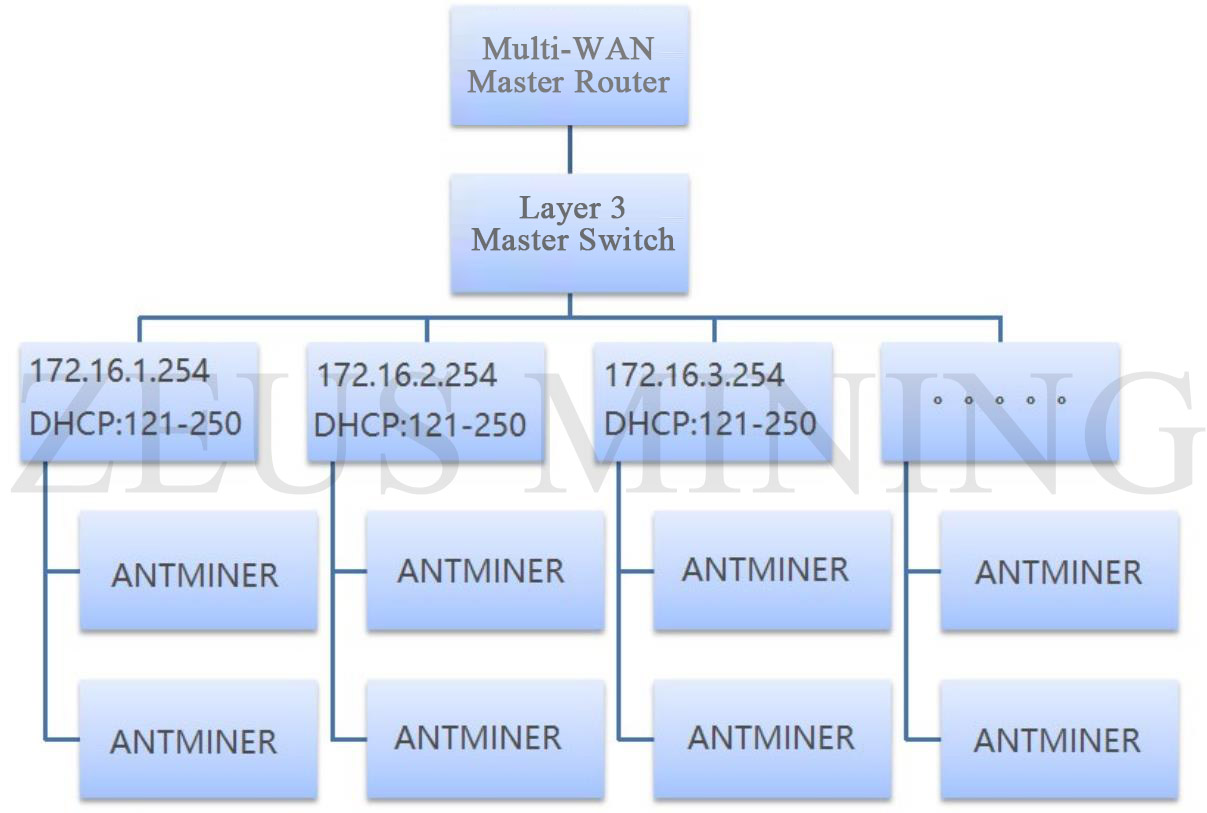
The division of the DHCP dynamic IP address range for each network segment needs to consider the possibility of using fixed IP addresses later. The length of the address lease period can be set according to the frequency of miners getting off and on each network segment. For example, if a rack frequently uploads and delists many miners daily, you can set the DHCP address lease period to 1-2 minutes. On the other hand, if a rack rarely launches and delists miners daily, you can set the DHCP address lease period to about 120 minutes.
At the same time, to prevent possible virus transmission, three-layer isolation is performed between network segments, and port isolation is recommended within each network segment.
II. Daily Regular Inspection
1. Hashrate check
(1) Check the hashrate of the miner every two hours. The batch management software BTC Tools can be used on site to view or log in to the corresponding mining pool website to check the hashrate. BTC Tools can set up pool miners in batches and check the hashrate temperature in real-time. It is recommended to install the Google Chrome browser and set it as the default. You can double-click the scanned miner to enter the backstage without filling in the user name and password. If the root password of the miner's backstage has been changed, when you need to fill in the user name and password in the browser, you can click "Settings" in the upper right corner of the BTC Tools software to change to a new password.
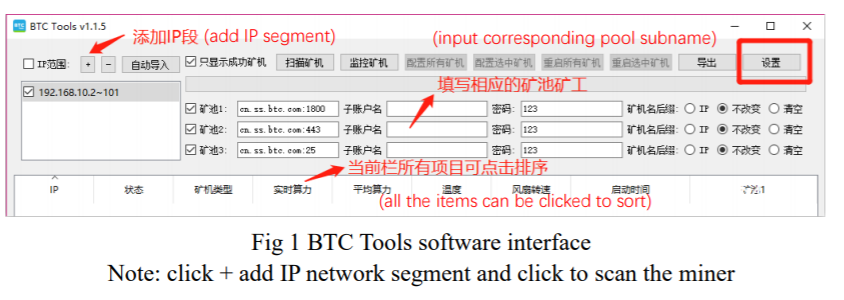
(2) Regularly check whether there are errors or omissions in the miner information of the miner in the mining pool. Except for the primary mining pool, the other two backup mining pools need to be filled in. It is recommended to change the miner's default root password and not download unofficial firmware and overclocking firmware upgrades to avoid illegally tampering with the mining pool miners by malicious firmware. APMinerTool software can be used to modify passwords in batches, and the software can also scan and manage miners.
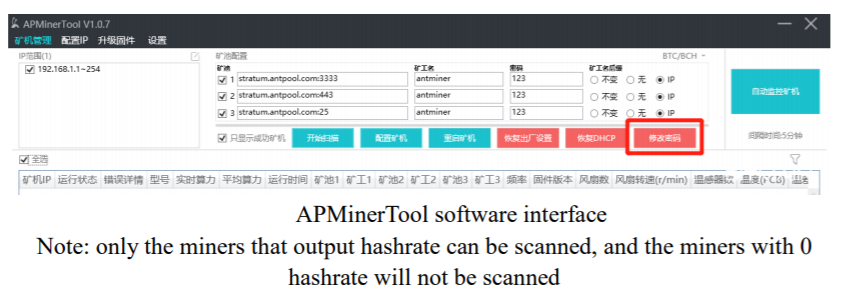
(3) The miner with abnormal hashrate is found to be investigated and resolved in time. Those not dealt with handled on-site are removed for repair or returned to the factory for processing.
2. Power Check
(1) Every day use a fluke 15b+ multimeter to check whether the voltage of the PDU socket of the miner is within the average value of 220V±10%. The voltage is too high or too low, which will cause unstable operation or failure to work, and may even burn the power supply or the miner. If the voltage is abnormal, please notify the electrician in time.
(2) Check the three-phase ammeter of the power distribution cabinet every day. If the deviation is more than 15%, notify the electrician to check whether the three-phase load is balanced. The unbalanced three-phase may cause a specific voltage increase. Therefore, it is necessary to distribute the miners to the three-phase circuit as evenly as possible Don't concentrate on a certain phase circuit.
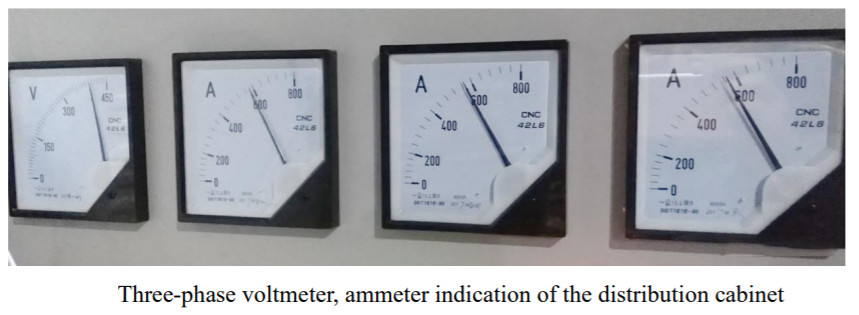
(3) Regularly check whether the miner is leaking electricity. Some miners have electrified shells due to improper grounding, and the control board and hash board can be easily damaged when the miner is running.
Method 1: Use a Fluke 15b+ multimeter to measure whether there is the voltage between the shell of the miner and the bare metal of the shelf when the miner is running. If there is voltage, the grounding is not done (this method requires that the shell of the miner is not in contact with the metal of the shelf).
Method 2: When the miner is running, measure whether there is the voltage between the miner's network port and the casing of the miner. If there is voltage, the grounding is not done well (this method requires that the metal cover of the miner's network port is not in contact with the control board of the miner). If the grounding is not done well, an electrician needs to deal with it in time.
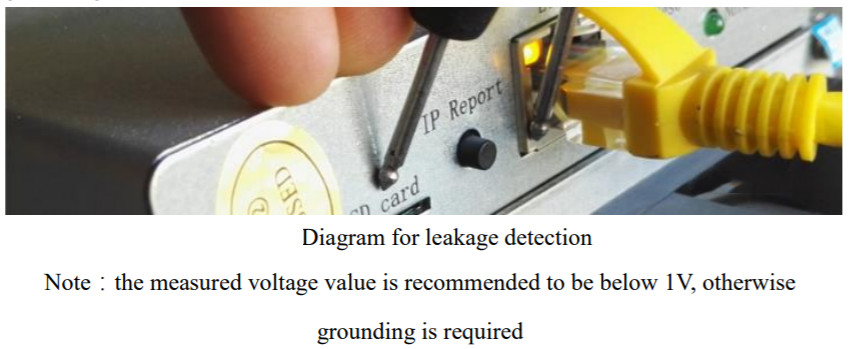
(4) Regularly check whether the plant shelf and the miner socket are grounded (grounding resistance is required to be less than 4Ω). If it is not grounded or the grounding is not secure, notify a professional electrician to do a good grounding in time. Numbness need to check whether the grounding is poor or not grounded.
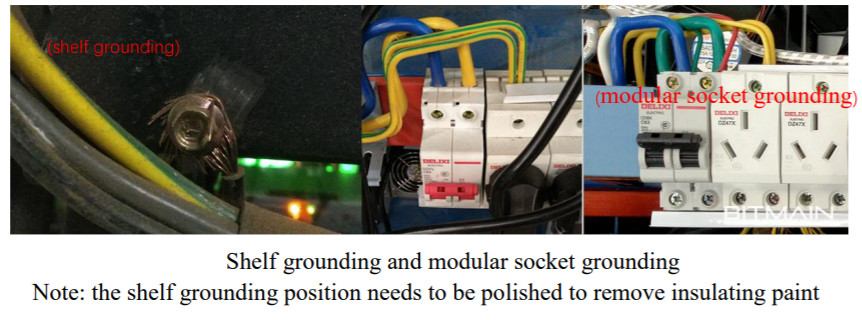
(5) Regularly check whether the wires and cables are aging. Use an infrared thermometer to detect whether the temperature of the circuit breaker, cable, copper bar, and each connector of the power distribution cabinet is abnormal. Deal with it in time.
(6) The miner should avoid frequent power outages and need to make a plan for power outages. When power is cut off, the power should be turned off from the minimum air switch on the shelf up to the master air switch level by level. Likewise, when powering on, it should be ensured that the air switch of the shelf connecting to the miner has been completely shut down, and the power is low level by level by the master air switch, to avoid the impact of the voltage surge and damage to the miner.
3. Network inspection
(1) Regularly check whether the spare broadband line is standard. You can connect the spare network cable from the router backstage or laptop to check. The miner network and the living network need to be separated separately to avoid network security when accessing unknown URLs in the living area and to prevent downloading and watching videos from occupying the network speed, which affects the connection between the miner and the mining pool, and the hashrate fluctuations. It is necessary for the network administrator to limit the speed of the IP in the living area on the router or switch side and do not visit unknown websites.
(2) Regularly Ping whether the delay of the mining pool used by the current miner is stable. If the delay is more than 100ms, you need to check the internal and external networks. The network manager will check whether the network equipment is faulty on the local area network. The broadband operator needs to check the equipment line for the external network. The delay is too high Will cause fluctuations in hashrate. The Ping function option is located in Network-Diagnostics. The current mining pool address cannot be pinged when checking the network with 0 hashrate. It is a network failure.
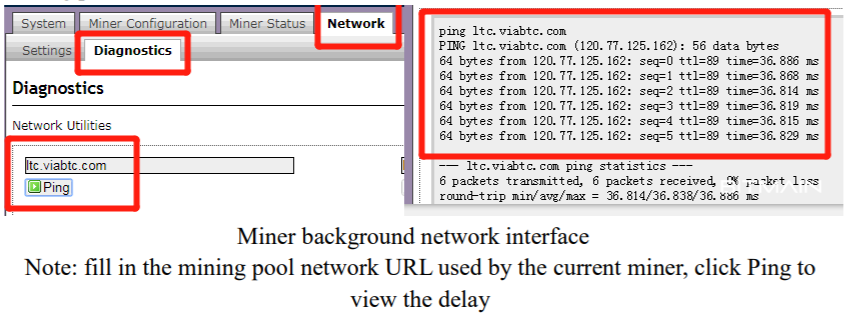
(3) Check the temperature of the network equipment every day. If the housing of the equipment reaches 45℃ or more, you need to change the position or install a fan to dissipate heat. Do not put the network equipment and network cable in the warm air outlet of the miner. If the CPU temperature of the network equipment is too high, it will affect the stability or even crash. The main network cable is recommended to use a better quality network cable. When the network is disconnected for more than 15 minutes, the miner should be turned off. The power consumption of the miner and the hashrate are corresponding. If the hash rate is insufficient or the power consumption is 0, the power consumption will be reduced accordingly.
4. Temperature and humidity check
(1) High-temperature check
Measure the temperature of the air inlet of the miner every day and try to control it at 10 to 25°C. Suppose the temperature near the air inlet of the miner exceeds 30°C. In that case, it is easy to cause high-temperature protection and 0 hashrate, and the ambient temperature needs to be reduced in time. It is possible to check whether there is a backflow of warm air at the miner's location. You need to pay attention to the fact that the small fan of some third-party power supplies and the miner fan has opposite wind directions, which causes the temperature to overlap. At this time, you need to reposition the power supply direction. High-temperature protection the hardware of the miner with 0 hashrate is not damaged. The hashrate can be restored after lowering the ambient temperature. The mine needs to formulate a plan to reduce the ambient temperature as soon as possible, such as installing water curtains, installing negative pressure fans, and isolating heat and cold.
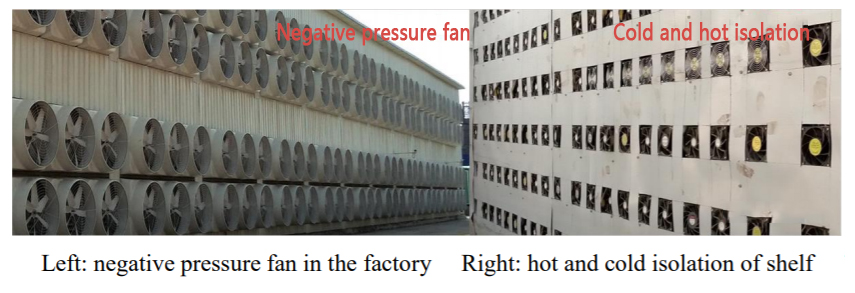
(2) Low-temperature check
The ambient temperature required for the operation of the miner is 0-40℃, but in cold northern regions (such as Inner Mongolia, Xinjiang, etc.), the low temperature in winter will reach minus 10-20℃. As a result, some antminers (such as 17E, 17+ series) are prone to burning, dropping, chip dropping, log prompting low-temperature protection, high-temperature protection, and temperature failure in low-temperature environments. Please click here to view the: Guide for mounting and maintenance of miners in low-temperature areas.
(3) Humidity check
Measure the humidity near the air inlet of the miner every day to check whether there is condensation in the shelf, miner, power cord, and other locations. If the humidity exceeds 65% RH, it needs to be lowered. The distance between the water curtain and the shelf will also increase the humidity. Generally, the distance between 2-3 meters should not be too close or too far (too far away will weaken the cooling effect). Long-term excessive humidity and poor air quality in the surrounding large chemical plants will accelerate the corrosion and even scrapping of the hashboard. You can reduce the amount of water in the water curtain as needed to reduce the humidity of the inlet air. It is recommended that the miner do not operate near the saline-alkali land or near the sea, which may easily lead to the oxidation and corrosion of the miner.
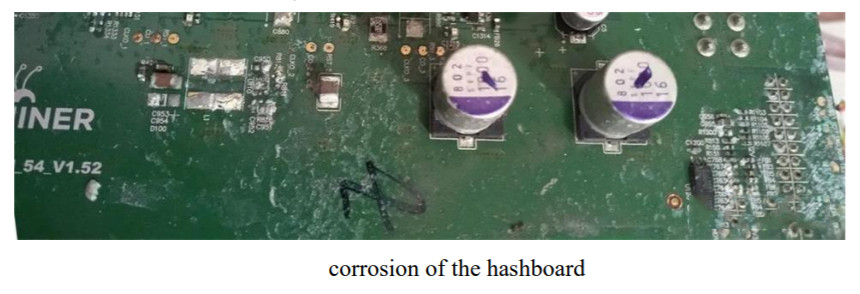
(4) Precautions for the use of water curtain
Check every day whether the water curtain is leaking to the ground inside the plant, whether the water flows evenly, whether there are white alkaline residues and clogging, the water curtain clogging or uneven water distribution will reduce the effect and affect the temperature. Clean the water curtain regularly. It is also necessary to regularly check whether the water curtain reservoir's water volume is average and whether the pump is abnormal.
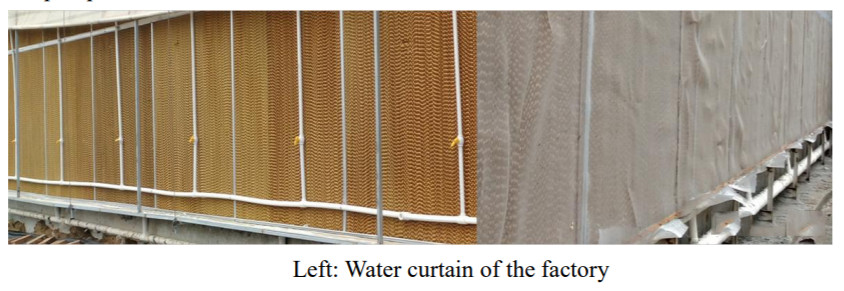
Left: Plant water curtain Right: Curtain with a layer of gauze
5. Environmental inspection
(1) Check the operation of the negative pressure fan of the plant every day to see if there is any slow rotation or stalling. The mine farm needs to be cleaned in place to free the ground of dust and paper.
(2) Regularly check the dust condition of the miner every month. You can unpack the front fan of the miner to view. If a large amount of dust, catkins, etc., are found to block the air duct at the position of the heat sink, the high-temperature protection needs to be cleaned up in time. Use a dust-removing fan to blow off the dust. Be careful not to use a brush that is too hard or uses too much force. Otherwise, it will easily cause the heat sink to fall off. After the brush is processed, use the dust remove fan to blow away the dust. (Note that when removing the fan, you only need to remove the four screws on the fan, not the screws with tamper-evident labels on the fuselage).

(3) In northern miner farms, there is generally a lot of wind, sand, and dust. Therefore, check the condition of the dust-proof net every week, and clean the dust-proof net with a vacuum cleaner and other tools regularly. If there is a lot of dust in the factory building but no dust-proof net is installed, it is necessary to take appropriate dust prevention measures in time.
(4) On rainy days, pay attention to prevent the workshop's rain or water from affecting the miner, especially the door position and some unclosed areas.
6. Visual inspection
(1) Check whether the air inlet of the miner of the plant is blocked by garbage and paper scraps every day, and clear it in time to avoid affecting the air volume and causing high-temperature protection to zero hashrate.
(2) Check whether the indicator light of the miner is expected every day, and the red light abnormality needs to be dealt with. Check whether the two fans of the miner are running, and if the fan blades are found to be damaged or not rotating, replace them in time. You can also check whether the fans are faulty from the Kernel log in the background of the miner. When replacing the fan, be careful not to install it backward. Otherwise, the air will not be exhausted out of the miner.
(3) Check whether the network cable is damaged and cannot be used, and whether the power cable is abnormally overheated. It is not recommended to use a one-half power cord that is easy to overload. When selecting a power cord under 220V voltage, it is recommended to purchase 10A or more, and the length should be within 1.5m.
III. Notes on installation and disassembly of the miner
1. Notes on Installation
(1) Check the appearance of the miner for signs of violent bumps, shake the miner to see if the heat sink has fallen out, and check whether the appearance of the two fans is damaged or deformed. For the new all-in-one miner, the exposed part of the copper busbar needs to be checked for lifting, which will cause failures such as board drop, and it needs to be restored in place and good contact.
(2) Before putting it on the shelf, check whether the cable (fan, power supply 6pin, hash board) is properly inserted and not loose, and the direction of the hash board power supply 6pin must not be plugged in the wrong direction. The control board cannot miss the 6Pin power cord, Will cause hashboard to burn or even scrap, and reverse plugging of the control board power cord will also cause the control board to burn. Looseness and reverse insertion may cause burn-in. The power cord and the socket should not be too loose or easy to contact. Pay attention when purchasing the socket and the power cord.
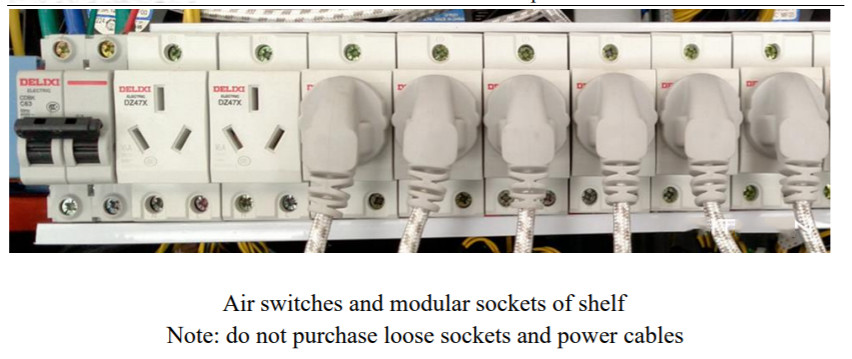
(3) When handling the miner, handle it gently. It is forbidden to carry the hash board cable or power cord directly, and it is forbidden to throw it away from a high place. Workers must inform the miners not to throw them away when they are transporting them. Otherwise, the heat sinks and chips on the internal hash board of the miners may fall, or the fans that hit the outside may be damaged or even scrapped.
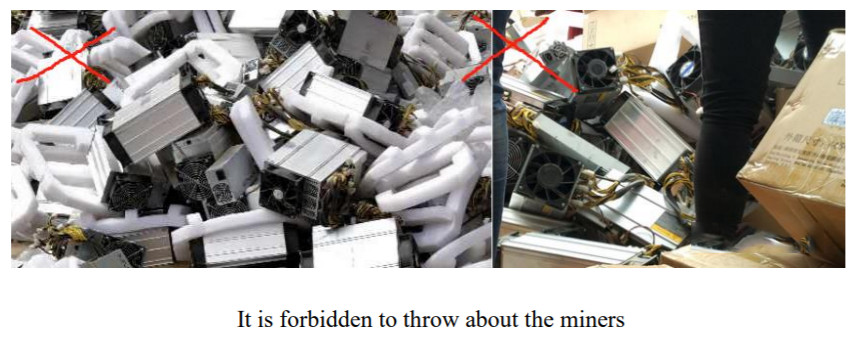
(4) After the new miner is on the shelves, use the batch software APMinerTool or BTC Tools to modify the mining pool miners, set a fixed IP as required, and confirm whether the miner's hashrate is average. When a single miner is put on the shelf, it is set to IP's original shelf position.
(5) When deploying miners in batches, pay attention to planning the IP to facilitate the subsequent fixation of the IP address, and the DHCP division and the static IP to be fixed are staggered. If there are 100 miners on the shelf, the gateway can be set to 172.16.1.254, the DHCP can be set to 172.16.1.101-240, and the reserved IP (1-100) is used for the subsequent fixed IP. Generally, one rack is managed by one network segment. To fix the IP addresses of miners in batches, you can use the "Configure IP" option of APMinerTool.
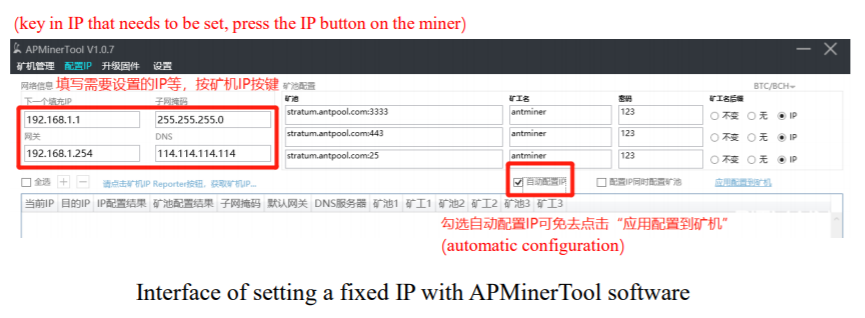
2. Notes on disassembly of the miner
(1) Reconfirm whether the miner failure can be restored to normal at the site before taking off the shelf. Generally, the site can solve the problems such as high temperature protection, fan failure, network failure, and system failure (the mine farm can purchase some fans as spares). Minimize the misjudgment of the fault and return to the regular after-sales miner. Fan failure judgment can be viewed from the Kernel log in the background of the miner. FAN2 and FAN5 in S9 and T9+ series fan logs belong to the corresponding relationship.
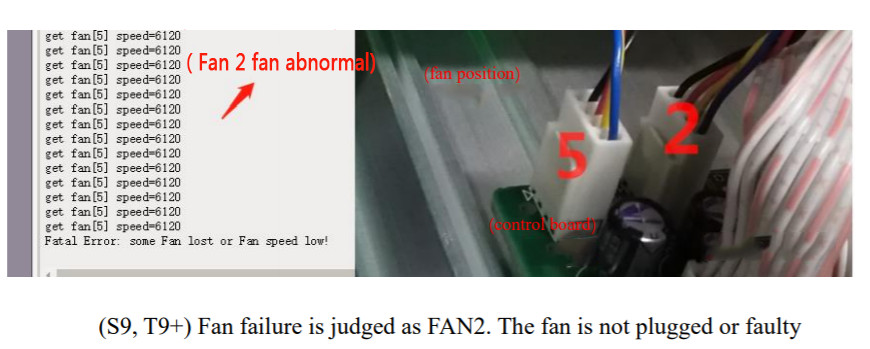
(2) Confirm whether the IP corresponds to the actual product to avoid mistakes. Suppose you are not sure about the IP of the miner. In that case, you can find the IP Reporter software IP Reporter directly click Start and then press the miner IP button or click the "Configure IP" option on the APMinerTool software and then press the miner IP button to confirm.

(3) Before removing and loading the miner, you need to cut off the power before operating it, handle it gently and do not handle the cable or power cord of the portable hash board. It is forbidden to throw it away from a high place.
(4) If the factory shelf has cold heat isolation, the vacancy after the miner is removed should be blocked to avoid warm air return. In addition, the miners off the shelf should be dust-proof and moisture-proof, placed smoothly and neatly in the designated area, wait for on-site repair or contact the nearest repair center.
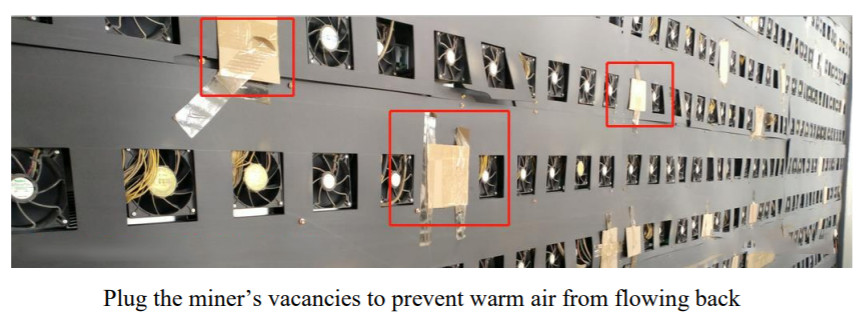
IV. Miner troubleshooting table
There are many reasons for the failure of the miner. Start by simply checking the network, upgrading the firmware, resetting, checking the cable, changing the power supply, cleaning the dust, lowering the ambient temperature, etc. If it is not solved, you need to check the power and environment. For post-sales processing that cannot be resolved at the site, the general idea can be as follows:
Troubleshooting Table V1.0 for Common Miner Faults | |||
No. | Miner Faults | Troubleshooting Method | |
1 | The miner is not powered | 1.Check whether the power supply and power cables are plugged in and powered | 1. Re-plug the line |
2 | Cannot scan the miner | 1.Restore to factory settings or power off, press IP report button to reset | 1. Re-find IP |
3 | Cannot visit or enter the backstage of the miner | 1.The original IP is inconsistent with the current network after the miner is relocated | 1. Change the current network to be consistent with the previous site |
4 | No data on the backstage or 0 hash rate | 1. Check if the fan cable is plugged in or the fan is faulty | 1. Replace the fan or re-plug the fan cable |
5 | The miner has insufficient board hash rate | 1. Check if the miner 6Pin power line and cable are plugged in firmly | 1. Re-plug the line |
6 | Miner’s red light flashes | 1. Check if the network is normal | 1. Check if the fan is faulty |
7 | Run for a period of time with fewer chips or partial chips. Enter X to restart normally | 1. Check the power supply | 1. Replace the power supply |
8 | Run for a period of time with whole hashboard chip X to restart normally | 1. Check the power supply | 1. Replace the power supply |
9 | Batch software scans a small number of miners | 1. Not add all network segments | 1. Re-add network segment |
10 | The miner runs for a period of time with 0 hashrate, restart to restore hashrate | 1. Check if the power supply is abnormal | 1. Replace the power supply |
11 | SD card recovery system failed | 1. Whether the card recovery image is wrong | 1. Copy the file again after formatting |
Ⅳ. Daily operation and maintenance inspection table
The items that need to be checked in the daily operation and maintenance of the mine are recorded and improved accordingly to reduce the failure rate.
Daily Operation and Maintenance Inspection Table of the Mining Farm V1.0 | ||||||
Inspection object | Inspection content | Reference value | Inspection result | Remark | Inspection date | Inspector |
Hashrate situation | Batch tool scans low hashrate | (unit) | ||||
Whether the mining pool miner is missing or wrong | (unit) | |||||
Number of miners in high temperature protection | (unit) | |||||
Power situation | Measure whether the socket voltage value is normal | 220V±10% | ||||
Whether the shelves and power outlets are grounded | Resistance <4Ω | |||||
Whether the value of the three-phase ammeter is balanced | Deviation within 15% | |||||
Detect if there is leakage in the miner | Voltage <1V | |||||
Network situation | Ping current mine delay | Below 100ms | ||||
Network equipment casing temperature | Below 45℃ | |||||
If the switch is powered off | ||||||
If the standby broadband line is normal | ||||||
Temperature and humidity | Air inlet temperature | Below 30℃ | ||||
Air inlet humidity | Below 65%RH | |||||
If the negative pressure fan runs normally | ||||||
Whether the shelf has warm air return | ||||||
If the water flow of the water curtain and reservoir is normal | ||||||
If the water curtain leaks or the alkali is not smooth | ||||||
Environmental situation | Miner dust situation | |||||
Factory catkin situation | ||||||
Factory floor and shelf dust situation | ||||||
Miner appearance | If there is foreign matter blocking at the inlet and outlet of the miner | |||||
If the miner fan does not turn or the fan blade is damaged | ||||||
If the miner tuyere and the hot and cold isolation port correspond | ||||||
Dear Customers,
Hello, April 4, 5 and 6, 2025 (GMT+8) are the traditional Chinese festivals - Qingming Festival. Our company will suspend shipments during these 3 days and resume shipments on April 7 (GMT+8). We are deeply sorry for the inconvenience. Thank you for your understanding and support.
Best wishes,
ZEUS MINING CO., LTD